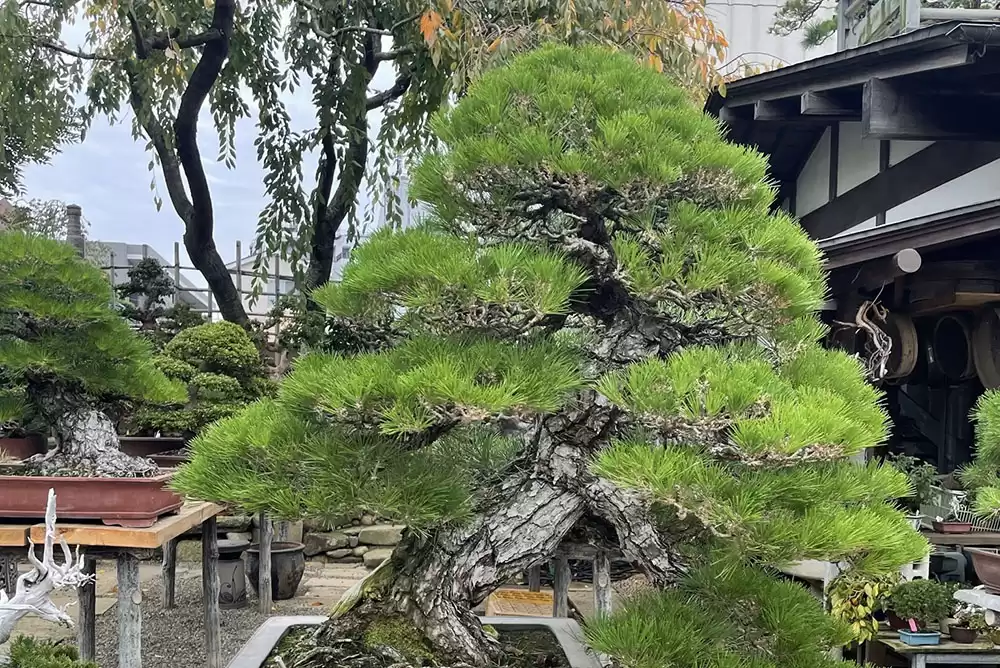
01 Oct How to Care for a Japanese Black Pine Bonsai Tree
Japanese black pine bonsai trees are exquisite additions to any garden or koi pond. Today’s article will explain the process of caring for these beautiful bonsai trees so they can thrive and enhance the aesthetics and tranquility of your outdoor space.
Understanding Japanese Black Pine Bonsai Trees
Before diving into care tips, let’s start to understand this plant a little bit more.
The Japanese black pine is scientifically known as “Pinus thunbergii.” Native to Japan and Korea, these bonsai trees hold deep cultural and aesthetic significance in Japanese gardening and culture. They are revered for their graceful appearance and symbolize longevity and resilience.
These bonsai trees can thrive in Los Angeles’ climate, making them ideal for a Japanese-themed outdoor space if you live in the area. Japanese black pines are also salt-tolerant, can withstand salt spray, and are often used in seaside landscapes.
Japanese black pines are known for their exceptional needle retention, making them suitable candidates for bonsai cultivation. They maintain their lush, dark-green needles even in the winter months.
Caring for Japanese black pine bonsai trees involves specific techniques and practices, including proper potting, pruning, and training to grow and continue to thrive. Continue reading to learn more.
Planting and Potting
Select a pot with good drainage, preferably one that is slightly larger than the root ball. Next, gather your materials: bonsai tree, pot, well-draining soil, mesh, wire, and pruning shears. Carefully remove the tree, preserve its roots, and trim any damaged ones.
Use mesh or a drainage screen on the holes, then create a base layer of soil. Place the tree and fill the pot with soil, eliminating air pockets. Water thoroughly after potting it. Lastly, add moss or pebbles for aesthetics and place the bonsai in an appropriate spot.
Watering and Moisture Control
Watering and moisture management are key to maintaining the health of your bonsai. They require consistent moisture, but not to an excessive degree.
Regularly check the moisture level by inserting your finger about an inch deep into the soil. If it feels slightly dry at this depth, it’s time to water your Japanese bonsai tree. Water it with a fine nozzle or a hose with a diffuser to prevent soil erosion. Once you see water draining out of the pot’s bottom, you will know it has been thoroughly watered.
Factors like temperature, humidity, pot size, and tree size determine how much water it needs. You may need to water every 2-4 days during the growing season and less during dormancy. Keep track of your watering schedule to maintain consistency and monitor your tree’s response. Healthy growth and vibrant foliage are indicators of proper moisture balance. Adjust your watering routine throughout the year based on environmental factors and the size of your bonsai tree.
Fertilizing and Nutrient Management
Fertilizing and managing the nutrient levels of your Japanese black pine bonsai tree is also essential to its longevity. Select a balanced, slow-release bonsai fertilizer with equal proportions of nitrogen (N), phosphorus (P), and potassium (K), such as a 10-10-10 or 14-14-14 mix.
Follow a seasonal fertilizing schedule such as this:
- Spring Fertilization: Apply a balanced, granular, slow-release fertilizer in early spring as the tree awakens from dormancy in preparation for the growing season.
- Monthly Fertilization: During the active growing season (spring through early autumn), use a liquid or water-soluble fertilizer with lower nitrogen content once a month. Dilute it to half the recommended strength.
- Late Summer Reduction: In late summer, reduce fertilization frequency to prepare the tree for dormancy. Apply granular slow-release fertilizer sparingly or discontinue liquid fertilization in early autumn.
Avoid over-fertilizing it because that leads to salt buildup and will eventually harm the roots. Always follow the recommended dosage instructions on the fertilizer packaging.
Alternatively, you can use foliar feeding or organic alternatives like compost or well-rotted manure. After applying fertilizer, water your Japanese bonsai tree thoroughly to distribute nutrients and prevent root burn. Repot your tree every 2-3 years, replacing the old soil with a fresh bonsai soil mix to provide new nutrients.
Protecting Japanese Black Pine Bonsais from Pests and Diseases
Proactive measures and attentive care include regular inspections, focusing on leaves, branches, and soil. When introducing new trees to your outdoor space, isolate them initially to ensure they’re pest and disease-free.
Keep your bonsai pruned and free from dead or diseased parts and place the tree in a spot with good airflow and adequate sunlight to discourage fungal diseases. Fungal diseases are easily preventable; do not water them from above, ensure the foliage dries before nightfall, and prune infected areas promptly.
Watch for common pests and address them through gentle removal or water treatment. Isolate and treat affected bonsai trees if needed, seeking expert advice when necessary.
Conclusion
Now that you know what it takes to maintain one of these trees, you are welcome to browse through our selection of Japanese bonsai trees. A Japanese black pine bonsai is a stunning addition to any koi pond, providing shade and beauty to your outdoor space.



